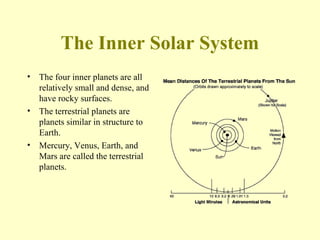
Inner Solar System Exploration
- 1. The Inner Solar System • The four inner planets are all relatively small and dense, and have rocky surfaces. • The terrestrial planets are planets similar in structure to Earth. • Mercury, Venus, Earth, and Mars are called the terrestrial planets.
- 2. The Sun • The sun’s energy is produced in its central region by the fusion of hydrogen nuclei into helium nuclei. • The sun remains stable because the inward pull of gravity balances the outward push of thermal pressure from nuclear fusion. Nuclear_Fusion_Joins_Atoms Nuclear_Fusion_Creates_New_Elements
- 3. The Sun’s Interior • The sun’s interior consists of the core, the radiation zone, and the convection zone. • Core – is the sun’s central region, where nuclear fusion occurs. • Radiation Zone – is a region of compressed gas. Energy is transferred by the absorption and reradiation of electromagnetic waves. • Convection Zone – The outer layer of the sun. energy is transferred outwardly by convection currents.
- 4. The Sun’s Atmosphere • Photosphere – the innermost layer of the sun’s atmosphere. It is the visible surface. • The photosphere is not a solid, but it is considered the surface. • Astronomers can’t see through the photosphere. • The_Photosphere_and_the_Solar_Wind
- 5. The Sun’s Atmosphere • Chromosphere – is the middle layer of the sun’s atmosphere. • At high temperatures, hydrogen emits a reddish color. • Chromosphere means “sphere of color”
- 6. Corona • The corona is the outermost layer of the sun’s atmosphere. • The gases are thin at this layer • The chromosphere and corona can only be seen during solar eclipses.
- 7. Stages of Solar Eclipse • The corona can only be seen from Earth during a total solar eclipse or when viewed with a special telescope.
- 8. Features of the Sun’s Atmosphere • Sunspots – small dark regions on the sun’s surface. • Sunspots are areas of gas in the photosphere that are cooler than the surrounding gases. • Sunspots give off less energy
- 9. Other Features • Prominences – occur near sunspots. They are huge loops of gas that erupts. • Solar Flares – the sun’s surface erupts hurling charged particles into space
- 10. Review Concepts • What is the source of the sun’s energy? • Nuclear fusion in the sun’s core. • What two forces in the sun interact to produce a stable structure? • Gravity and the thermal pressure from fusion. • List the layers of the sun’s interior from the center outward and describe each one. • Core: central region where fusion takes place; Radiation zone: middle layer, energy is transferred by radiation; convection zone: outer layer, energy is transferred by convection. • List the layers of the sun’s atmosphere • Photosphere, chromosphere, corona • List three features that exist on the sun’s surface. •Sunspots, Prominences, and Solar flares
- 11. Debbie’s sun Exploring_Space__The_Universe Video_Quiz__The_Sun__Our_Star_Attraction
- 12. Mercury • Mercury is the smallest of the terrestrial planets and the closest planet to the sun. • Mercury is a dense planet with a very large iron core. • Mercury is geologically dead. • There is no mantle convection within the planet and little erosion on its surface.
- 13. Venus • Venus’s thick atmosphere is composed mostly of carbon dioxide, which traps heat and raises the planet’s temperature. • Venus’s atmosphere contains droplets of sulfuric acid. • Average surface temperature 460 degrees.
- 15. Mars • Mars is the most Earthlike of all of the planets. The weathering of iron rock on its surface gives the planet a reddish color. This is why Mars is called the “Red Planet.”
- 16. Mars
- 17. Asteroids • Beyond Mars is a region of small, rocky bodies called asteroids that orbit the sun. • This region is referred as the asteroid belt • Scientist now hypothesize that asteroids are remnants of the early solar system that never came together to form a planet